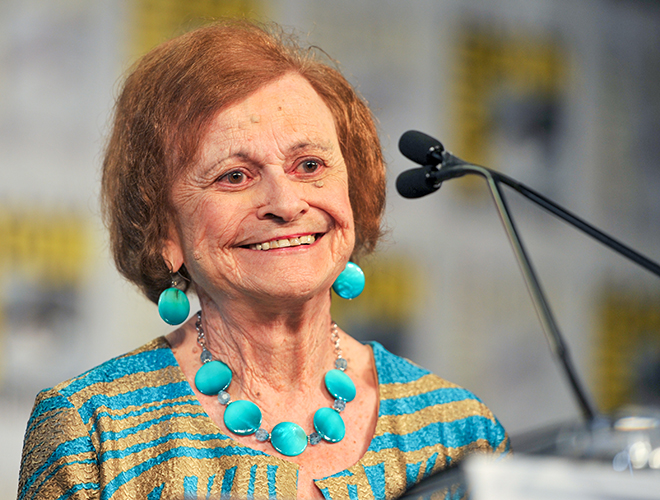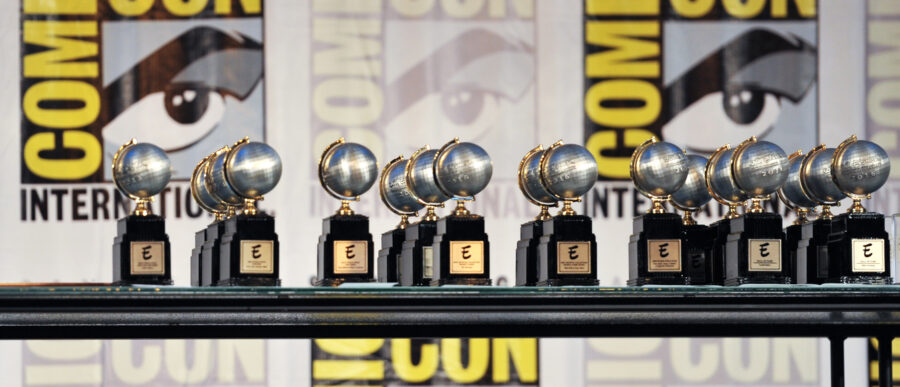The highly successful business of popular culture is based, in part, on a medium that was denigrated and despised throughout much of its history — comic books. As San Diego Comic-Con celebrates its 50th anniversary, Knowledge at Wharton technology and media editor Kendall Whitehouse reflects on how one of the premiere events at the pop culture festival, the Will Eisner Comic Industry Awards, seeks to rectify that history.
Marvel Studios’ Avengers: Endgame, based on a team of superheroes who first assembled in a 1963 comic book, is moving ever closer to becoming the biggest box office hit in cinema history. Five of the top 10 highest grossing movies of all time are based on comic book properties. Superheroes may now be big business, but the early years of the medium on which much of today’s entertainment is based were markedly different.
Comic-Con International: San Diego (or, as it is more commonly known, San Diego Comic-Con or simply SDCC) is an enormous event that descends on the Southern California city each July. With an estimated regional impact of over $147 million, the event attracts a reported 135,000 attendees, six times the next largest conference held at the San Diego Convention Center.
The fan fest covers the full gamut of movies, television, video games and comic books, yet a commonly heard complaint among attendees is that Hollywood has taken over the event. Although the largest presentations in the Convention Center’s mammoth 6,500-seat Hall H typically focus on upcoming Hollywood blockbusters, comic books are still in evidence in myriad panel sessions and vendor booths.
Comic books are also in sharp focus on Friday evening each year at the Will Eisner Comic Industry Awards.
The Oscars of Comic Books
Generally considered the “Oscars” of the comic book industry, the Eisner Awards have been held at San Diego Comic-Con since their inception in 1988 and have been under the stewardship of Comic-Con International since 1990.
Nominees in each category are chosen by a panel of judges and voted on by comic book writers, artists and other industry professionals. Many of the awards recognize the medium’s creative professionals: writers, artists, colorists and letterers. The global scope of the medium is recognized in awards for U.S. editions of international material. The diverse age range of the audience is acknowledged in separate awards for publications targeted at early readers (up to age 8), kids (ages 9–12) and teens (ages 13-17).

A number of awards (technically not Eisners but awarded by Comic-Con International during the Eisner Award Ceremony) recognize lifetime achievement. The Bob Clampett Humanitarian Award honors people in the industry “who have worked to help others.” The Bill Finger Award for Excellence in Comic Book Writing, created in 2005, recognizes writers “for a body of work that has not received its rightful reward and/or recognition.”
This desire to redress the lack of recognition for comic book creators permeates many of the comics-focused events at Comic-Con. Throughout much of the medium’s history, comic books were considered, at best, a juvenile recreation and, at worst, a dangerous menace. While the blockbuster films based on comic book properties have in recent years given the medium a degree of grudging acknowledgement, it is still viewed by many as puerile entertainment.
During earlier periods in the history of the medium, it was worse.
Testifying Before the Senate
On April 21 and 22, 1954, the Senate Judiciary Subcommittee to Investigate Juvenile Delinquency, chaired by New Jersey Senator Robert C. Hendrickson, turned its attention to comic books as a stimulus of youthful misbehavior. The hearings were dominated by Estes Kefauver, the crusading Tennessee Senator who rose to fame in earlier televised hearings on organized crime. Testifying before the Committee was psychiatrist Fredric Wertham. “The comic books, in intent and effect, are demoralizing the morals of youth,” Wertham was quoted as stating in a 1948 Collier’s magazine article. “They are sexually aggressive in an abnormal way. They make violence alluring and cruelty heroic. They are not educational but stultifying.” His testimony before the Senate Committee doubled down on this position.
The comic book industry was represented by Bill Gaines, publisher of EC Comics, whose grisly horror tales were a particular target of the Committee. While Gaines attempted to assert that “Entertaining reading has never harmed anyone,” he was no match his inquisitors, who came armed with images from some of EC Comics’ most sensationalistic covers. Gaines faltered trying to explain how the cover of Crime SuspenStories #22, which showed a man holding a decapitated head and a bloody axe standing over the body of the dead woman, was in good taste.
In response to the hearings and the general public outcry, in October 1954 a group of the leading comics publishers formed the Comics Magazine Association of America. The consortium established the Comics Code Authority which oversaw a set of guidelines for the content of comic books. The code’s injunctions particularly seemed to target Gaines’ EC Comics. In addition to banning nudity, torture and the like, it forbade the use of the words “horror” or “terror” in a comic’s title.
Superheroes may now be big business, but the early years of the medium on which much of today’s entertainment is based were markedly different.
The publicity from the hearings also reinforced the sense of shame and embarrassment of those working in the industry. “In the 1950s comic book creators were equated with pornographers,” writer and artist Howard Chaykin observed at last year’s East Coast Comicon (an event unaffiliated with the San Diego convention). “I used to hide the fact that I was in comics,” artist John Romita is quoted as saying in Marvel: Five Fabulous Decades of the World’s Greatest Comics. “We used to say we were in commercial illustration rather than admit we were comic book artists.”
Toiling in Anonymity
Compounding the ignominy, working in the industry was also not particularly profitable. Throughout most of the medium’s history, artists and writers were paid a meager per-page rate and did not retain the rights to the characters they originated.
Superman’s creators, writer Jerry Siegel and artist Joe Shuster, sold their initial story along with all rights to the character for $130 in 1938. The man from Krypton would go on to become one of the most profitable fictional characters in history. “The contract Siegel and Shuster signed became the original sin of the comic book industry,” Julian Voloj, author of The Joe Shuster Story: The Artist Behind Superman, told the website Comics Beat.
Even within the insular world of comic books, creators have often gone without significant reward or recognition.
From Batman’s first appearance in Detective Comics #27 in 1939 through the lauded trilogy of films directed by Christopher Nolan in 2005-2012, the Dark Knight’s creation was credited to a single individual: Bob Kane, the artist who first drew the character. Much of the work attributed to Kane over the years was done by uncredited ghost artists. The contributions of Bill Finger, who wrote most of the early Batman stories and was responsible for much of the character’s iconography, were excluded. A sustained campaign by writer Marc Tyler Nobleman and other fans goaded publisher DC Comics into providing a co-credit for Finger in the comic books and the Gotham television program starting in 2015 and on the 2016 film Batman v Superman: Dawn of Justice.
Getting Better All the Time
In recent decades, the tendency to deprecate comic books has slowly abated. Comics are increasingly being seen as offering significant cultural and artistic contributions
In 1987-1988 the Smithsonian’s National Museum of American History presented Superman: Many Lives, Many Worlds featuring the medium’s first breakout star. In 2010, Time magazine named Watchmen, the 12-issue comic book series by writer Alan Moore and artist Dave Gibbons, one of the best English-language novels published since the magazine’s launch in 1923. This year’s exhibition, MARVEL: Universe of Superheroes, features more than 300 pieces of artwork, costumes and props from comic books and films. The exhibition opened at Seattle’s Museum of Pop Culture (could one even imagine such a place decades earlier?) and is now on display at Philadelphia’s Franklin Institute.
Financially, the industry has experienced a number of booms and busts over the decades. After a downturn in 2017, last year showed renewed growth, with U.S. and Canadian sales of comic books and graphic novels breaking $1 billion in 2018, an $80 million increase over 2017.
Throughout most of the medium’s history, artists and writers were paid a meager per-page rate and did not retain the rights to the characters they originated.
Of course, this pales in comparison to the major media properties based on the characters in these comic books. A single film, Avengers: Endgame, has currently grossed over $2.77 billion globally.
Meanwhile, in San Diego
At San Diego Comic-Con, the Eisner Awards advance the appreciation of the art of comic books and counter the long history of disparagement of the medium and lack of recognition for its creative talent.
Last year, the Bill Finger Award for Excellence in Comic Book Writing went to two women. Joye Hummel Murchison Kelly worked with Wonder Woman creator William Moulton Marston and authored a number of the character’s stories which were credited to “Charles Moulton,” Marston’s pen name. Dorothy Roubicek Woolfolk worked as a writer and editor for major comic book companies including Marvel, DC, and EC Comics.
“The comic book industry employed too few women in its early decades … and what few there were went totally unrecognized,” stated comics writer and historian Mark Evanier, who chairs the award committee. “The work of these two extraordinary ladies deserves to be acknowledged and celebrated.”
The 2019 Bill Finger Awards will go to Mike Friedrich and E. Nelson Bridwell, two writers “who are way past-due for some rightful recognition,” according to Evanier. Friedrich began writing professionally at age 18, initially working for DC Comics where he wrote for characters including Batman and The Flash. He later moved to Marvel Comics where he scripted stories of Iron Man and others. Bridwell began his career at Mad magazine before moving to DC Comics where he wrote for multiple superhero titles. “Both were among the first human beings who went from reading comics to writing letters-to-the-editor that were published in comics and then on to writing the comics themselves,” noted Evanier.
This year, San Diego Comic-Con celebrates the 50th anniversary of the popular arts festival. The programming schedule includes an array of presentations focusing on the history of comic books and the convention that, for half a century, has celebrated the medium. On the evening of Friday, July 19, the Will Eisner Comic Industry Awards will again recognize some of the men and women who work to keep the medium vibrant.
For updates from this year’s Comic-Con International: San Diego, which begins July 17 with a preview night and continues through July 21, follow Whitehouse’s Twitter feed and blog, On Technology and Media.



